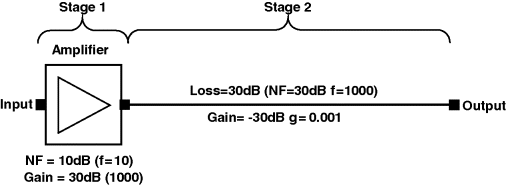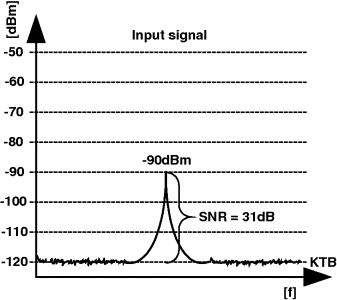7.3 Noise Power
From the example in Section 7.2, it is clear that the NF could be improved by installing the amplifier prior to the coax cable. Place the amplifier as near as possible to the signal, the antenna. However, it is also a matter of having control of the noise power, especially in noise-sensitive systems like UMTS/HSPA. In these systems the SNR of the system plays a major role for the high data rate services.
Let us have a closer look at what happens with the input signal as shown in Figure 7.9 (−90 dBm) and the noise in the system. Backing up the calculations with a ‘spectrum analyzer look’, it all becomes more obvious, compared with ‘just’ looking at formulas.
7.3.1 Calculating the Noise Power of a System
An example of a pre-amplifier 30 dB gain with 10 dB NF and 30 dB loss on cable is shown in Figure 7.8. The spectrum in Figure 7.9 looks at the input signal.
Figure 7.8 Pre-amplifier solution, −90 dBm input signal

Figure 7.9 Signal at the input of the pre-amplifier solution

Signal-to-noise Ratio at the Input of the Amplifier
This is a GSM system operating at 200 kHz bandwidth; the KTB is −121 dBm (noise floor) and we can calculate the signal-to-noise ratio:
![]()
or in dB, ...
Get Indoor Radio Planning: A Practical Guide for GSM, DCS, UMTS, HSPA and LTE, Second Edition now with the O’Reilly learning platform.
O’Reilly members experience books, live events, courses curated by job role, and more from O’Reilly and nearly 200 top publishers.

